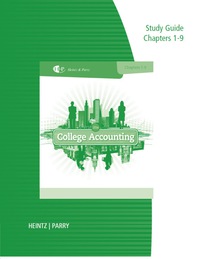Question
Parent Company bought 70% of the outstanding common shares of the Subsidiary Company on December 31, year 5 at the cost of $130,000. At that
Parent Company bought 70% of the outstanding common shares of the Subsidiary Company on December 31, year 5 at the cost of $130,000. At that date, the Subsidiary had 10,000 common shares outstanding originally issued for $105,000. The retained earnings on that date were $45,000.
Subsidiary had 900 of $3 cumulative preferred shares outstanding redeemable at a 10% premium to face value. The preferred shares were issued at their face value of $150,000. No preferred shares were owned by the Parent. All preferred share dividends were declared and paid for each year.
When the subsidiary was purchased, the book values of the identifiable assets were equal to their fair values except for two assets. Equipment had a fair value of $27,000 higher than its book value. The fair value of inventory was $5,000 less than its book value. Equipment had a remaining useful life of 8 years on that date and no salvage value. There was a goodwill impairment loss of $2,400 in year 7 and $8,000 in year 9. Both companies use the straight-line method of depreciation.
Additional information
1. Subsidiary sold $70,000 of inventory to the Parent during year 8. On December 31, year 8, 30% of this inventory remained unsold. This inventory was sold externally during year 9.
2. Parent sold $90,000 in inventory to the Subsidiary during year 9. Subsidiarys inventory on December 31, year 9 included $27,000 of unsold inventory from the Parent.
3. Both companies have a 40% gross profit of sales and a 40% income tax rate.
4. The Parent lent $30,000 to its Subsidiary on July 1, year 9. The Subsidiary signs a 7% promissory note.
5. During year 9, the companies declared and issued stock dividends: $18,000 for the Parent and $10,000 for the Subsidiary.
6. On January 1, year 8, the Subsidiary some of its land and equipment to its parent. The land was sold for $10,000 and the equipment for $35,000. The book value of the land was $6,000 and the book value of the equipment was $15,000. The parent estimated the useful life of the equipment at 6 years at the time of its purchase from its Subsidiary.
The condensed financial statements were as follows:
Parent Company Statements of Income and Retained Earnings Year ended December 31, year 9
Parent Subsidiary
Sales $400,000 $270,000
Other Income 25,400 30,000
Cost of goods sold 315,000 240,000
Other expenses 36,400 15,000
Income tax expense 26,000 20,000
Profit 48,000 25,000
Retained earnings, Jan. 1 25,000 60,000
Dividends (18,000) (10,000)
Retained earnings, Dec. 31 $55,000 $75,000
REQUIRED: Show all your schedules for the following consolidation: a) Prepare the calculation and allocation of acquisition differential schedule b) Prepare the acquisition differential amortization and goodwill impairment schedule c) Prepare schedules for intercompany transactions, unrealized profits on intercompany transactions, and deferred taxes schedules. d) Calculate consolidated net income for the year with income attributed to the Parent and NCI. e) Prepare the consolidated income statement for the year ended December 31, year 9.
Step by Step Solution
There are 3 Steps involved in it
Step: 1

Get Instant Access to Expert-Tailored Solutions
See step-by-step solutions with expert insights and AI powered tools for academic success
Step: 2

Step: 3

Ace Your Homework with AI
Get the answers you need in no time with our AI-driven, step-by-step assistance
Get Started


